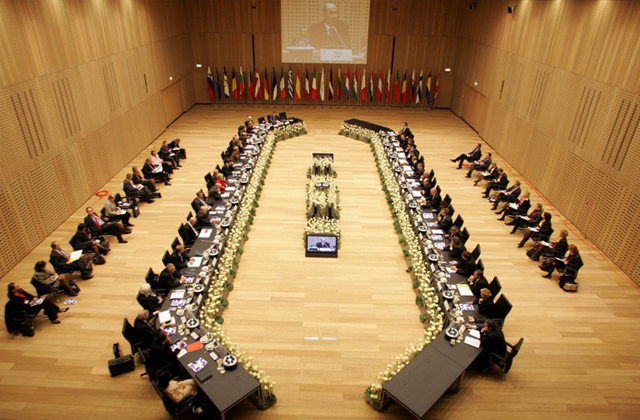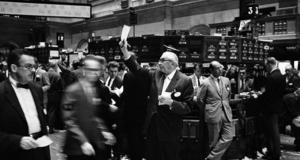From Cornell International Affairs Review VOL. 3 NO. 1A World of Financial Models: The French Touch in Deregulation, 1980-2009
IN THIS ARTICLE
KEYWORDS
September 15th, 2008. Lehman Brothers files for bankruptcy. The Anglo- American model of finance collapses. This is a “Big Bang” for the global financial markets. The months following saw a rush to rebuild the premises of the financial markets and set the stage for a regulatory revolution. The G-20 meetings have offered some first steps towards a global compromise. Change. This word, perhaps overused in other contexts, is insufficient to describe the revolution that is taking place in the organization of American finance. But, apart from the media buzz and the populist rhetoric of politicians, can we expect the Anglo- American organization of finance to change that dramatically? Will the G-20 lead to global convergence on new terms? Warren Buffet, referring to the current financial crisis, has famously said: “when the tide goes out, you see who has been swimming naked.” The American and British banks in general seemed to have left their swimsuits on the beach and to have dived into the ocean of risk-taking, and of complex financial products. Current estimates place the assets of banks at around $1.2 trillion, and the liabilities at $2.5 to 4.9 trillion. This gap illustrates the magnitude of the risks taken by banks. The French banks, operating in a transformed French deregulated and market-based political economy, seem to have remained dressed while swimming in the waves. Understanding how the French model of finance has evolved and how far it has changed in reaction to external factors will allow us to understand the dynamics of change in financial systems. This article will argue that financial systems do change, and sometimes radically, but they do not abandon their national or regional specificities. The result of external pressures leads to transformed systems, which is not always an alignment on dominant market practices. Behind the convergence of “best practices,” different sets of values and institutions will produce different models. Underlying cultural and institutional frameworks mediate the changes, and distinct settings produce distinct outcomes. Looking at the French case, I will show how global pressures and the competition with the US and Great Britain have radically transformed French finance. I will also examine the nature of the pressures of European harmonization. They have influenced the evolution of the French model by integrating it in the Single Market. But the deregulation of France had its limits. Specific features mediated the external pressures and produced a transformed yet distinct French model, which kept a flexible but robust approach to financial regulation. The excesses of the Anglo- Saxon model were avoided. The tides change, but what people wear or do not wear in the water does not change that quickly. They need time to remake themselves, and they remake themselves differently. This article will argue that the limits to French convergence towards the Anglo- American model of finance are the result of two key features: a specific culture of French elites and their relationship with the state, and the universal bank structure of the French financial system. Why should we look at France for guidance in understanding change in financial models? The French case is enlightening because it is a particularly hard case for convergence, as it was historically very regulated. The French financial system started in the 1980s as what Zysman calls a “credit-based price administered” system (1983). Today, it is a market-based system. This dramatic transformation illustrates the power of the markets in forcing change. But when we look at the details of the new system, France did not converge entirely towards an Anglo- American financial system. It created its own system, with a balanced approach to markets. The culture and the institutions of France constrained the global and regional pressures to reinvent a different model. The Transformation of French Finance: Deregulation from the 1980s to the 2000sFrench finance was transformed and deregulated from the mid-1980s to the 2000s. It has adapted to globalization. The financing of the French economy evolved from being credit-based to market-based. The regulatory framework is more flexible and allows financial institutions to take more risks. This seeming convergence towards a liberal model was a “little big bang” (Cerny 1989), and as Schmidt reminds us, the French system, compared to Great Britain and the US, is the country that has changed the most (1996). However, France remains distinct in the regulation of its transformed model, and the convergence towards the Anglo-Saxon model remains partial. The underlying values and approach to regulation remain distinct. This contradiction between the power of external factors in changing France and the survival of a distinct model is puzzling. In this section, the transformation of France and its distinct outcome are briefly exposed. Changes in French Finance (1980s-2009)France in 1980 was a credit-based system with government-administered prices, in contrast to the British and American models, which were market-based and allocated resources by competitively establishing prices (Zysman 1983, 18). The financing of the economy was based on credit, and financial markets were secondary and accessible only for a particular set of large companies for operations controlled by the state (Zysman 1983, 123). France was an “overdraft economy,” a “political economy that has become dependent on the allocation of credit by institutional lenders (Loriaux 1991, 9). This system was based commercial banks that accompanied firms with long-term financing. France in 2007 was very different. The financial system was transformed. Michel Barnier, in the Cornell International Affairs Review, explained that France “has passed from one era to another, from a closed-in and regulated world to a world open to exchange and to competition” (2007, 6). The financing of the economy is based on the financial markets and the issuance of bonds and stock, rather than by bank loans. The French firms finance themselves essentially on the financial markets, and this behavior is similar to the actors on the American liberal market (Culpepper 2006, 50). The capital raised on the stock exchanges in France went from being negligible in France in the early 1980s to being the main source of financing of French firms. "The French have reacted to the global challenges of regulation by retaining a strong but flexible role for regulation." The French banks are now freed from the full control of the state. They are able to engage in many risky operations. French banks propose complex financial products. They are global actors that compete with American financial institutions (Padoa-Schioppa 2004, 55). The French financial players are important and competitive in an increasingly integrated world (Larosière 2007, 13). French banks are strongly involved in the securities markets and organize many deals. In 2006, BNP Paribas organized 63 operations, accounting for 108 billion euros. The financial sector in 2007 represented five percent of the GNP (Lagarde 2008). The French market is also very open to international banks. The American banks have been advisors on more than 60 percent of the investment banking deals originated in France in 2006, and four of the five largest deal winners in France were American: Goldman Sachs, Merrill Lynch, Morgan Stanley, Citigroup (Larosière 2007, 21). This French evolution is recognition that in a world where the financial assets have been “soaring,” to reach 3.5 times the world GDP in 2006, to enhance efficiency, you have to take advantage of these assets rather than use only the capital-consuming national credit-based financing (SIFMA 2008, 5). Similarly to the US, the overthe- counter (OTC) market has expanded significantly. Michel Prada, former chairman of the French securities regulator, underlined the importance of the unregulated OTC market in France. Many new complex financial products are traded on this market on which no regulator has jurisdiction.1 The French credit default swap (CDS) market is very important, as well as the market for securitized products, such as collateralized debt obligations (CDO) and other similar products (FBF 2009, 9). There is an externalization of risks from the banks balance sheets, and we have dissemination of risk in the hands of many actors on the markets.2 The French financial markets follow the international rules established by the Basel Committee on Banking Supervision (Kapstein 1994, 103). The recent Basel II framework and its refinement of the capital adequacy requirements and improved risk management is an illustration of how the French financial supervision has converged (Larosière 2007, 23; Artus and Virard 2008, 81). The Basel Committee is a work in constant progress, and different sub-committees meet constantly, leading the French model to evolve and converge with the other financial centers.3 The international accounting standards are slowly harmonizing thanks to the international financial reporting standards (IFRS). The cooperation of the national securities regulators in the framework of the International Organization of Securities Commissions (IOSCO) leads to an increase in convergence of the international regulations (Schmidt 2002, 37). The IOSCO Technical Committee, chaired by the Frenchman Michel Prada (who explains this in his article in the Cornell International Affairs Review), led to the establishment of a set of international standards for securities transactions.4 French markets seem to have converged significantly. This contrast between the 1980s and the 2007 is the result of a series of deregulatory reforms enacted by successive governments that for reasons of space we cannot go over here (See Loriaux, Abdelal, Hancké, La Serre and others). The Distinctiveness of French Finance in a Globalizing worldFrance, although it has changed and converged towards a liberal model, remains distinct (Culpepper, Hall and Palier 2006, 16). What characterizes this distinctiveness? France is not quite a liberal market economy (LME) as underlined by Culpepper (2006, 63). Indeed, Hancké reminds us that “the French political economy retains, even after capital markets have become more flexible, specifically French characteristics” (2001, 334). The underlying values of French finance and of French regulation remain distinct and maintain a robust regulation in a new framework. The French regulators remain tâtillon and look at details. Indeed, they keep a culture of control and inspection that is very detailed, and looks not only at the processes that the bankers follow when they do a market operation, but they pay special attention to the products themselves and the evaluation of the risk of the product. Prada emphasizes this aspect of French regulators, and underlines the common sense approach that is taken by the regulators, which, he implied, contrasted with a more ideological approach in other countries that believed that the market actors were inherently right and that detailed controls were not required.5 A member of the Commission Bancaire, the French banking supervisor, emphasized this French characteristic with respect to the approach to the supervision of the prudential ratios of French banks.6 The French have reacted to the global challenges of regulation by retaining a strong but flexible role for regulation. Perhaps the strongest illustration that France remained distinctive in its regulation of the financial markets is that the financial crisis hit French banks as a consequence of American excesses, rather than as a consequence of French excesses. Although it did uncover some excessive risk-taking and some failures in risk management, most of the losses came from products that were originated outside of France and that were brought in by banks that were diversifying their portfolios.7 Although France changed from its early 1980s political economy, it did not abandon its specificities, and still has robust regulations of its financial markets. This is a puzzling outcome. Given the power that external forces have had in changing the French political economy in general and in particular the organization of its financial markets, it is puzzling that France kept a distinct approach to the regulation of its new model. The new system is a deregulated market-financed system, with the government out of the markets, and fairly light regulations that give an important level of freedom and flexibility to financial actors to innovate. The composition of the French financial markets and their regulation is in general similar to the American or British markets. However, this is not a blind convergence towards the American or the British approach to the regulation of the financial markets. The notion of self-regulation has not permeated the French system. So there is a limit to convergence theories and to the victory of markets. Global Changes and Their Impact on Financial SystemsIn the last few decades, at the global level, technological changes and innovations have strongly impacted the organization of the financial industry. This led to a series of changes towards the deregulation of the financial sector and a new approach to finance. These global changes also led to a heightened competition both between financial institutions and between financial centers, leading to interjurisdictional competition (Vaillancourt 2007). These global factors influenced all countries. They influenced France in particular and made a reform of its financial system necessary. France liberalized starting in the 1980s (Loriaux 1991). The deregulation of the financial markets continued in the 1990s and 2000s, and the role of the state in the financial system was redefined (Culpepper 2006). As a result of these global pressures, France partially converged towards a deregulated model and took the state out of the markets. Technological InnovationsTechnological changes have been quite important in the last decades, and they have promoted competition. Technology has been seen as a factor that would force convergence between national political economies towards a set of ‘best practices’ required by the new technologies. The most important technological changes have been the information, communication and technological innovations (OECD 2008, 14). These technological changes were dramatic (Comte-Sponville 2004, 199). These technological changes are primarily developments in electronic communication, telecommunication, transportation and data processing. New information and communications technologies also led to “dematerialization.” This term characterizes the process by which securities ownership, which used to be in the form of physical certificates, was converted into electronic records. These technological innovations allowed financial institutions to get around a lot of regulations. Regulations that separated different activities in the financial markets quickly became obsolete. Non-bank financial institutions became competitors of banks for certain products. Banks needed deregulation to have a level playing field in which they could compete fairly. As a result, new technologies and innovations led to the process of conglomeration (Padoa-Schioppa 2004, 57). This led to the creation of bigger financial institutions that had the ability to give all sorts of financial products. The financial actors took advantage of these technological changes and innovated, creating new financial products and new ways of dealing with risk. In turn, these innovations impacted the financial system and increased deregulation. Innovations in Financial ProductsThere have been many innovations in the financial markets. New financial products were produced by the “Quants” and sold on the markets. The “Quant era” started in the mid-1980s, when these math and physics PhDs created and priced new investment structures (Salmon 2009). These innovations offered higher remunerations, and what was believed to be lower risk. They changed the composition of the markets, in particular by increasing the size of the global unregulated over-the-counter (OTC) market, on which complex financial products were exchanged between financial institutions. The process of securitization is perhaps the most important of these innovations. Securitization has two meanings: the increased reliance on securities to finance an economy or a process by which complex financial products are created by packaging different vanilla products together. It is the second meaning which is referred to here. Guy Moszkowski underlines the importance of the securitization process, which consists of “putting together a pool of assets that provide a regular cash flow, tranching it, and selling different layers of risk to different investors.” 8 Other innovations such as the CDS, CDO and others also were developed. The outcome of the combination of innovations and of this set of incentives was a global environment in which regulations were more relaxed and financial institutions were more daring. France did not escape this general trend.9 The impact of technological evolution and innovation on the financial services industry is not new. Already in the Middle-Ages, the invention of letters of credit between Flemish and Italian markets was a little revolution in finance. The difference today is the suddenness and amplitude of these technological changes and innovations, which are transforming the value scales, distances, time and production processes (Lencquesaing 2007, 7). Since the 1970s, the flows of investments have changed radically and changed the relationship between the state and the markets to the advantage of the markets (Ohmae 1991, 161). These technological changes and innovations in financial products cannot be tamed by the regulators, and this led to a global environment in which deregulation was seen as the desired outcome (Calomiris 2000, 247; Stiglitz 2003, 255). Competition has also been a crucial factor in deregulation, but again, for reasons of space, these elements developed elsewhere will be left out of this article. Regional Market Pressures: Globalization with a Political FaceThe French financial markets deregulation is also a European story. This section shows how the European Commission, as a consequence of its political strategies to achieve European harmonization, played a role in accelerating and coordinating the deregulation movement that member states initiated. It was difficult for the European Commission to impose a common regulatory framework that would have forced member states to abandon their national specificities. Given its structural weakness, it had to rely on political strategies to harmonize the markets. These strategies reinforced the global pressures for deregulation. The Commission forged winning coalitions by using the differences in objectives between those who wanted liberalization as an end in itself and those who saw it as a necessary intermediate goal for long term political integration. The Commission unified them around the shared objective of harmonization and was able to pass its directives. Because of this strategy, the directives came down on the side of global markets. The Commission also used competition between national regulatory systems to promote harmonization outside of the legislative process. This strategy of promoting interjurisdictional competition and using market forces as a tool to harmonize reinforced the deregulatory pressures on France. The European Union as an Actor for Harmonization and DeregulationThe European Union is an important actor in the regulatory arena. Through the policies of the European Commission, it has had a role in furthering harmonization and deregulation of the national regulatory frameworks. Schmidt goes even farther and argues that “Europeanization has represented a strong force for change, stronger than globalization” (2002, 14). Although this process was already started at the national levels in most member states by the time harmonization and deregulation of the financial services industry became a European Union policy, the actions of the European Union have had a significant role in accelerating and coordinating the national reforms. It served as a “locus of coordination of market reforms” (Jabko 2006, 58). To respond to the new challenges in financial supervision, in particular the internationalization of the financial groups who increasingly operate on a cross-border basis, the European Union has furthered cooperation and coordination between national regulators. There are three supervisory committees, which are part of the level 3 of the Lamfalussy process, and have the objective to promote supervisory convergence. They are the Committee of European Banking Supervisors (CEBS), the Committee of European Securities Regulators (CESR), and the Committee of European Insurance and Occupational Pensions Supervisors (CEIOPS). These committees play a very important role in harmonizing the rules of supervision of the member states (SIFMA 2008, 28). They are a place of cooperation and coordination between national supervisors, who keep different approaches.10 This evolution in the Commission’s approach to legislating on financial regulation and the development of these committees added more pressures on France to converge towards a deregulated model. Harmonization on Market Terms and the Weakness of the CommissionThe European Commission has improved the harmonization of the frameworks for financial regulation in the member states. This was a difficult task given the structure of the European Union and the ambition of the objectives. Indeed, the ability of the Commission to force member states to agree to its policies was limited and harmonization is inherently difficult as states have to change their systems and sometimes lose their specific competitive advantages. As a consequence of the tension between the ambitious objectives and the limited means to achieve them, the Commission could not simply craft a framework for financial regulation and impose it to the member states. Competition and deregulation seemed like the only options to achieve harmonization. It is difficult to impose reforms that create losers, as the losers face clear costs and mobilize in a stronger form than the winners. Indeed, the gains for the winners would be on a longer time horizon and more diffuse. If there is a central authority that can easily coerce the losers to accept their faith, then the collective good can be attained. But when there is no central coercive authority, as at the EC level, then implementing the common interest becomes harder. The problem becomes more difficult when the winners and the losers are not only sub-sectors of the financial services industry or specific firms, but member states themselves, as may be the case in the transformation of the financial system as a whole. As a consequence of the difficulty of harmonization, the Commission cannot provide its own framework and impose it. It has to rely on compromise, and the easiest compromise is to deregulate, rather than change the regulation models of all member states to one tightly regulated model. Deregulation as a Result of a Coalition-Making Strategy for HarmonizationIn this context of difficult harmonization, the European Commission has elaborated a political strategy to build a winning coalition of actors capable of bringing reforms and passing directives. This strategy was based on bringing together groups that did not share the same vision on liberalization. It managed to bring together these “strange bed fellows” by playing on the ambiguity of the final objectives these groups pursued. The neo-liberal Anglo-Saxons wanted to have the European Union as a free-market zone with no barriers, and with a deregulated financial system. The continental groups saw financial market integration on deregulated terms as an intermediate objective which would enable the emergence of a political Europe. These different groups formed a coalition that allowed the European Commission success in harmonization and deregulation. This strategy increased the pressures on France to deregulate. To achieve a winning coalition to liberalize finance was not a given, and this strategy was a tool to succeed in a difficult mission. The promoters of Europe managed to bring different actors with different interest together. Harmonization meant deregulation to a certain extent, and the loss of many powers of the state over the financial markets. The natural coalition that supported this objective was formed by the neoliberal actors, the international business groups, and the states that would benefit from more deregulation. But this coalition was a minority, even within the Commission’s bureaucracy. The promoters of Europe used the long-term objectives of European integration shared by many actors in order to bring them to compromise on liberalization as a necessary moment to further integration. They argued that the deregulation and liberalization was only an “intermediate” goal that was necessary to make the ideal of a united Europe a reality. Liberalization, then, became a difficult but necessary medicine to swallow. This strategy did indeed succeed in bringing together “strange bedfellows” that did not share common long term objectives. The winning coalitions that were forged allowed the European Union to coordinate deregulation of member states and to harmonize through a series of directives. These directives, because of the composition of the coalition, liberalized the markets and have put an additional pressure on France to deregulate. A Strategy of Interjurisdictional Competition and DeregulationHarmonization of the financial sector, past a certain level of relatively consensual convergence, becomes harder when the resilient aspects of the national models are concerned. The European general interest was in stronger contradiction with the national interests of certain member states. The capacity of the European Union to broker compromises and to forge winning coalitions to produce legislation was further constrained when the regulations they tried to harmonize the resilient regulations. As the harmonization process reached some core aspects of national models and the implications for the competitiveness of financial centers get bigger, the Commission turned to the promotion of interjurisdictional competition as the central tool for harmonization. This strategy of competition, in context of mutual recognition of financial regulations across the European Union put in place by the 1992 plan, led to important pressures on national financial centers to deregulate in order to stay competitive. Theses pressures did not come specifically from directives that legally required deregulation, but rather from market forces. This also increased the pressures on France to deregulate. This strategy of promoting competition played by the European Commission is the product of the constraints of its weakness, but also of the ideas that came to dominate the Commission in charge of these policies. This strategy has increased the reliance on market pressures to force convergence of national regulatory frameworks for financial services and have let competition define the general interest. This competition leads to deregulation, and harmonization around minimum regulatory requirements. Therefore, politics at the European Union level play a crucial role in French deregulation. Global European Union factors have put strong pressures on France to deregulate its financial system.Continued on Next Page » Suggested Reading from Inquiries Journal
Inquiries Journal provides undergraduate and graduate students around the world a platform for the wide dissemination of academic work over a range of core disciplines. Representing the work of students from hundreds of institutions around the globe, Inquiries Journal's large database of academic articles is completely free. Learn more | Blog | Submit Latest in Economics |






















